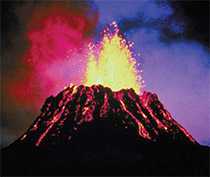NCEH State Fact Sheets: Hawaii
CDC 24/7: Saving Lives. Protecting People from Health Threats. Saving Money through Prevention.
Environmental Health
 Your environment is everything around you—the air you breathe, the water you drink, the community around you, the places where your food is grown or prepared, your workplace, and your home. When your environment is safe and healthy, you are more likely to stay healthy. But when your environment exposes you to dangerous events or toxic substances, your health can be affected negatively.
Your environment is everything around you—the air you breathe, the water you drink, the community around you, the places where your food is grown or prepared, your workplace, and your home. When your environment is safe and healthy, you are more likely to stay healthy. But when your environment exposes you to dangerous events or toxic substances, your health can be affected negatively.
CDC is committed to saving lives and protecting people from environmental hazards by responding to natural and man-made disasters, supporting public health workers, educating communities, and providing scientific knowledge. We help maintain and improve the health of Americans by promoting a healthy environment and preventing premature death and avoidable illness caused by environmental and related factors. We also identify how people might be exposed to hazardous substances in the environment and assess exposures to determine if they are hazardous to human health. CDC invests in prevention to improve health and save money by reducing healthcare costs. We remain committed to maximizing the impact of every dollar entrusted to the agency.

Asthma
An estimated 132,403 adults and children in Hawaii had asthma (2008). Among adults in Hawaii with active asthma, 40% reported an asthma attack in 2009.
From: http://www.cdc.gov/asthma/
stateprofiles/Asthma_in_HI.pdf
and
http://www.cdc.gov/brfss/acbs/
2009/AFA_PREVALENCE_09_
TABLE4b.HTML
Funded Activities
National Asthma Control Program
(FY 2013 funding for Hawaii—$508,000. A new funding announcement has been released; FY 2014 funding information will be available later in the year.)
Asthma is a common disease on the rise, with significant health care costs. Nearly 1 in 12 Americans (26 million) have asthma. In the last decade, the proportion of people with asthma grew by nearly 15%.
CDC has been working with states for more than 10 years to implement interventions, build local coalitions, and track the impact of the disease on the U.S. population.
The program focuses on what works to control asthma: assessing and measuring changes in disease severity and control, using the right medications, educating people to manage their conditions, and controlling environmental irritants and allergens.
Even though the number of people with asthma has increased over the last 10 years, trends show that more are controlling their disease:
Public Health in Action
Volcano Helpline and Asthma Education Help Hawaii Residents with Asthma

Hawaii’s volcanic emissions, or vog, create unique concerns for asthma care. Elevated levels of air pollutants that make up vog have been linked to breathing problems and an increase in emergency department visits among persons with asthma. With support and funds from CDC’s National Asthma Control Program, Hawaii maintains the Hawaii Volcano Helpline. Residents can call toll-free for daily updates on volcanic emissions and a recorded asthma message with tips for avoiding complications. As of 2012, the helpline has received more than 20,000 calls.
In rural Hawaii, CDC funds support asthma care among children living in medically underserved areas. For several years, the Hawaii State Asthma Control Program and its partners have worked with community health centers to improve asthma care outcomes as part of its Childhood Rural Asthma Project. For example, the project worked with community health centers to incorporate education about environmental triggers into standard asthma care. More recently they trained outreach workers how to help families get rid of asthma triggers where they live. This has resulted in fewer days with asthma symptoms, reduced medication use, and fewer doctor visits.
Through these interventions, other community-based efforts, improved surveillance and a strong coalition, Hawaii reduced its asthma hospitalization rates by 28% in just five years (between 2003 and 2008).
Top of Page- Page last reviewed: April 29, 2014
- Page last updated: April 29, 2014
- Content source:


 ShareCompartir
ShareCompartir